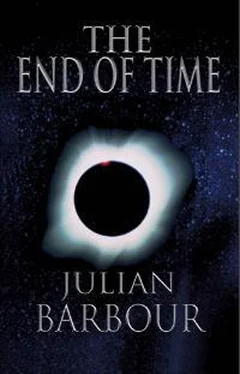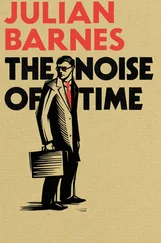In relativity theory, the construction of ‘three-dimensional’ snapshots from two-dimensional photographs is greatly (but not insuperably) complicated by the fact that light travels at finite speed, so that objects are no longer where they seem to be. Readers familiar with relativity theory and concerned that my concept of a Now seems very non-relativistic are asked to defer judgment until Part 3. Einstein did not abolish Nows, he simply made them relative.
Laws and Initial Conditions(p. 22) Although Newton’s and Einstein’s laws work equally well in both time directions, there is one known phenomenon in quantum physics that seems to determine a direction of time at a truly fundamental level. It is observed in the decay of particles called kaons. Paul Davies discusses this phenomenon in some detail in his About Time . Most authors are agreed that this phenomenon does not seem capable of explaining the pronounced directionality of temporal processes, which is one of my main concerns in this book, but it is probably very important in other respects and may provide evidence that time really does exist as an autonomous governing factor in the universe. However, the evidence that it defines a direction in time is indirect, being based on something called the TCP theorem. Although this is most important in modern physics, what form if any it will take in the as yet non-existent theory of quantum gravity is not at all clear.
THE PHYSICAL WORLD AND CONSCIOUSNESS
The discussion in Chapter 1 prompts the question of how our sense of the passage of time arises. Before we can begin to answer this, we have to think about another mystery – consciousness itself. How does brute inanimate matter become conscious, or rather self-conscious?
No one has any idea. Consciousness and matter are as different as chalk and cheese. Nothing in the material world gives a clue as to how parts of it (our brains) become conscious. However, there is increasing evidence that certain mental states and activities are correlated with certain physical states in different specific regions of the brain. This makes it natural to assume, as was done long ago, that there is psychophysical parallelism: conscious states somehow reflect physical states in the brain.
Put in its crudest form, a brain scientist who knew the state of our brain would know our conscious state at that instant. The brain state allows us to reconstruct the conscious state, just as musical notes on paper can be transformed by an orchestra into music we can hear. By the ‘state’ of a system, say a collection of atoms, scientists usually mean the positions of all its parts and the motions of those parts at some particular instant. It is widely assumed that conscious states, in which, after all, we are aware of motion directly, are at the least correlated with (correspond to) brain states that involve not only instantaneous positions but also motions and, more generally, change (associated with flow of electric currents or chemicals, for example). This is a natural assumption. Our awareness of motion and change is vivid and often exciting: think of watching gymnastics, or the 100-metre sprint final in the Olympic Games. We suppose that the impression of motion must be created by some motion or change in the brain.
However, if the physical processes in the brain are controlled by laws like Newton’s, such an assumption runs up against the problem that they distinguish no direction of time. Figure 1, with its impossibility of saying in which direction time flows, makes this clear. It is no help to go from its three particles to billions of them. Observed effects should have a real cause. The chain from cause to effects may be quite long and take surprising forms, but a cause there must be. It is unsatisfactory to suppose that we have a direct awareness of an invisible flow of time. Our sense of the passage of time and, even more basically, of seeing motion and knowing its direction, ought to have a cause we can get our hands on.
The lack of time direction in the bare laws of motion led Boltzmann to a remarkable suggestion (quoted in the Notes). As we have seen, Newtonian systems can enter highly ordered phases. These are exceptionally rare periods separated by ‘deserts’ of monotony. Nevertheless, every now and then a system will enter one. Its entropy will go down, reach a minimum, and then start to increase.
We should not think of this happening in a definite direction of time. Instead, we should picture the states of the system strung out in a line, as in Figure 1, which we could ‘walk along’ in either direction. Every now and then, with immense stretches between them, we will come upon regions in which the entropy decreases and the order increases. Then the entropy will start to increase again. Someone ‘walking’ in the opposite direction would have the same experience. Now, such a line of states can represent the entire universe, including human beings. Since we are very complicated and exhibit much order, we can be present only in the exceptional regions of low entropy.
Boltzmann’s suggestion, startling when first encountered, was that conscious beings could exist on either side of a point of lowest entropy, and that the beings on both sides would regard that point as being in their past. Time would seem to increase in both directions from it. In this view, time itself neither flows nor has a direction; it is at most a line. It is only the instantaneous configurations of matter, strung out like washing on the line, that very occasionally suggest that time has a direction associated with it. The direction is in the washing, not the line. What is more, depending on the position in the line, the ‘arrow’ will point in opposite directions.
This, then, gives a genuine cause for our awareness of motion and the passing of time. The conscious mind, in any instant, is actually aware of a short segment of the ‘line of time’, along which there is an entropy gradient. Time seems to flow in the direction of increasing entropy. Interestingly, consciousness and understanding are always tied to a short time span, which was called the specious present by the philosopher and psychologist William James (brother of novelist Henry). The specious present is closely related to the phenomenon of short-term memory and our ability to grasp and understand sentences, lines of poems and snatches of melody. It has a duration of up to about three seconds.
The key element in Boltzmann’s idea is comparison of structures. There needs to be qualitative change in the brain patterns along a segment of the ‘line of time’. If the brain pattern in each instant is likened to a card, then the patterns become a pack of cards, and our conscious experience of time flow arises (somehow) from the change of pattern across the pack. Though we may not understand the mechanism, the effect does have a cause.
To summarize: Newtonian time is an abstract line with direction – from past to future. Boltzmann keeps the line but not the direction. That belongs to the ‘washing’. But do we need the line?
TIME WITHOUT TIME
Perhaps not. The brain often fools us. When we first look at certain drawings, they appear to represent one thing. After a while, the image flickers and we see something different. The reason is well understood: the brain processes information before we get it. We do not see things as they are but as the brain interprets them for us. There are very understandable reasons for this, but the fact remains that we are often fooled by such ‘deceptions’.
Could all motion be a similar deception? Suppose we could freeze the atoms in our brains at some instant. We might be watching gymnastics. What would brain specialists find in the frozen pattern of the atoms? They will surely find that the pattern encodes the positions of the gymnasts at that instant. But it may also encode the positions of the gymnasts at preceding instants. Indeed, it is virtually certain that it will, because the brain cannot process data instantaneously, and it is known that the processing involves transmission of data backwards and forwards in the brain. Information about the positions of the gymnasts over a certain span of time is therefore present in the brain in any one instant.
Читать дальше












